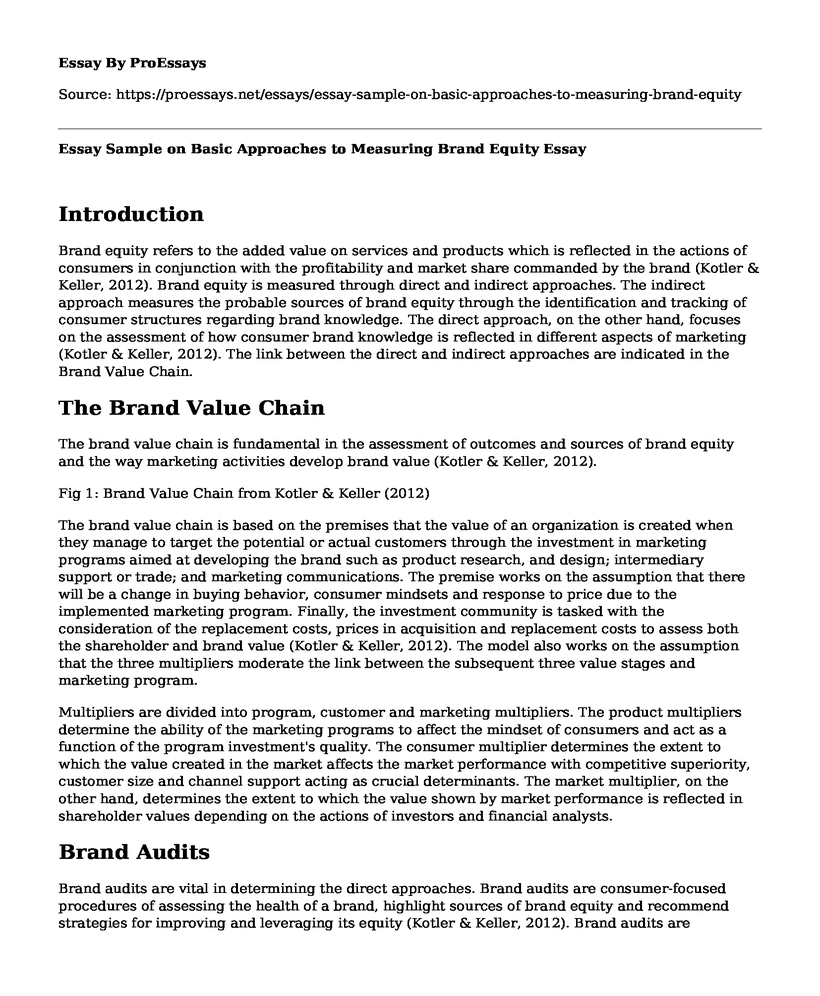Introduction
Brand equity refers to the added value on services and products which is reflected in the actions of consumers in conjunction with the profitability and market share commanded by the brand (Kotler & Keller, 2012). Brand equity is measured through direct and indirect approaches. The indirect approach measures the probable sources of brand equity through the identification and tracking of consumer structures regarding brand knowledge. The direct approach, on the other hand, focuses on the assessment of how consumer brand knowledge is reflected in different aspects of marketing (Kotler & Keller, 2012). The link between the direct and indirect approaches are indicated in the Brand Value Chain.
The Brand Value Chain
The brand value chain is fundamental in the assessment of outcomes and sources of brand equity and the way marketing activities develop brand value (Kotler & Keller, 2012).
Fig 1: Brand Value Chain from Kotler & Keller (2012)
The brand value chain is based on the premises that the value of an organization is created when they manage to target the potential or actual customers through the investment in marketing programs aimed at developing the brand such as product research, and design; intermediary support or trade; and marketing communications. The premise works on the assumption that there will be a change in buying behavior, consumer mindsets and response to price due to the implemented marketing program. Finally, the investment community is tasked with the consideration of the replacement costs, prices in acquisition and replacement costs to assess both the shareholder and brand value (Kotler & Keller, 2012). The model also works on the assumption that the three multipliers moderate the link between the subsequent three value stages and marketing program.
Multipliers are divided into program, customer and marketing multipliers. The product multipliers determine the ability of the marketing programs to affect the mindset of consumers and act as a function of the program investment's quality. The consumer multiplier determines the extent to which the value created in the market affects the market performance with competitive superiority, customer size and channel support acting as crucial determinants. The market multiplier, on the other hand, determines the extent to which the value shown by market performance is reflected in shareholder values depending on the actions of investors and financial analysts.
Brand Audits
Brand audits are vital in determining the direct approaches. Brand audits are consumer-focused procedures of assessing the health of a brand, highlight sources of brand equity and recommend strategies for improving and leveraging its equity (Kotler & Keller, 2012). Brand audits are conducted when considering strategic shifts and setting up marketing plans. By conducting the audits on a regular basis, the marketers can keep in track with their brands and manage them more responsively and proactively.
Brand-Tracking Studies
Tracking studies are vital in establishing Indirect approaches to measuring brand equity. Collecting quantitative consumer data is collected for a specific period to create a baseline information that is consistent with how the marketing programs and the brand performing (Kotler & Keller, 2012). These studies are key to understanding in what ways, how much and where brand value is created to facilitate the daily decision making in the organization.
The direct and indirect approaches of measuring brand equity are complementary. To guide the decision making of a firm and perform effectively strategic functions marketers need to know both the sources of brand equity and its effect on consumers in conjunction with how the sources change with time.
Reference
Kotler, P., Keller, D., Lane, K., (2012). Marketing Management, Fourteenth Edition, Pearson Prentice Hall. Retrieved from http://socioline.ru/files/5/283/kotler_keller_-_marketing_management_14th_edition.pdf
Cite this page
Essay Sample on Basic Approaches to Measuring Brand Equity. (2022, Nov 13). Retrieved from https://proessays.net/essays/essay-sample-on-basic-approaches-to-measuring-brand-equity
If you are the original author of this essay and no longer wish to have it published on the ProEssays website, please click below to request its removal:
- Paper Example on Branding
- Essay Sample on Truth in Advertising
- Research Paper on Walmart Inc
- Essay on Integrating WMS with ERP to Improve Supply Chain Management
- Essay Sample on Walmart Targets 95% of Population: Wealthy to Middle-Class
- Adapt or Fail: Change is Inevitable for Organizations - Essay Sample
- Report Sample on Amazon: From 'Get Big Fast' to Global Retail Giant







